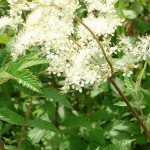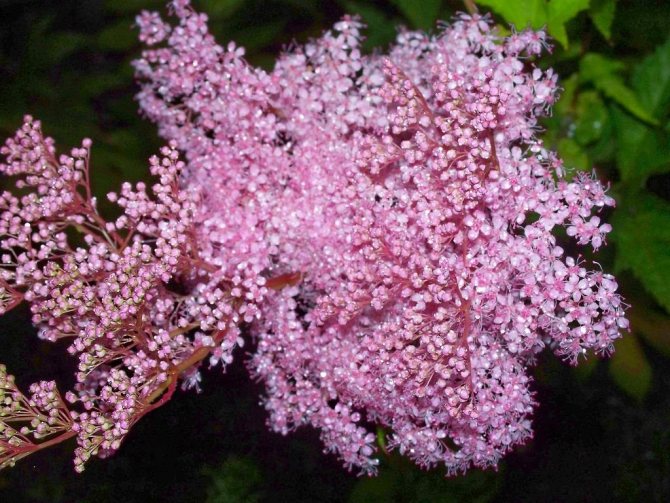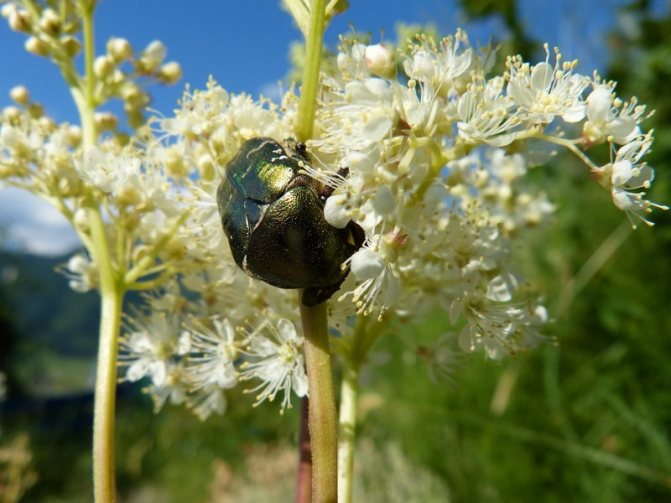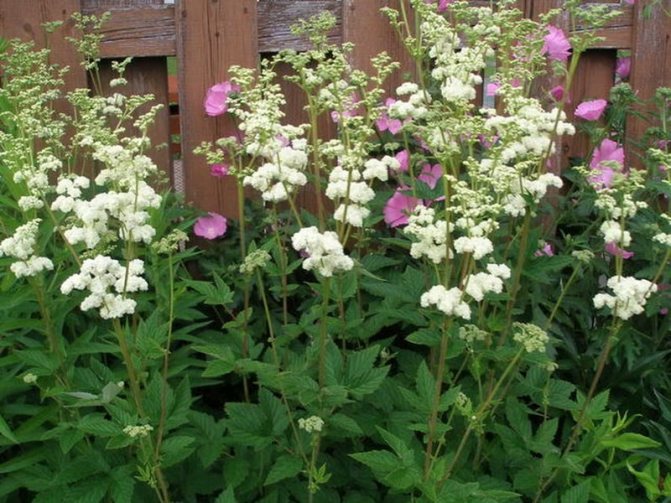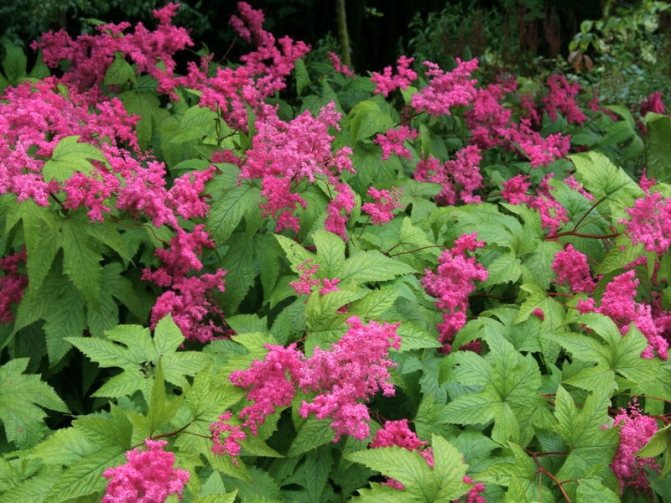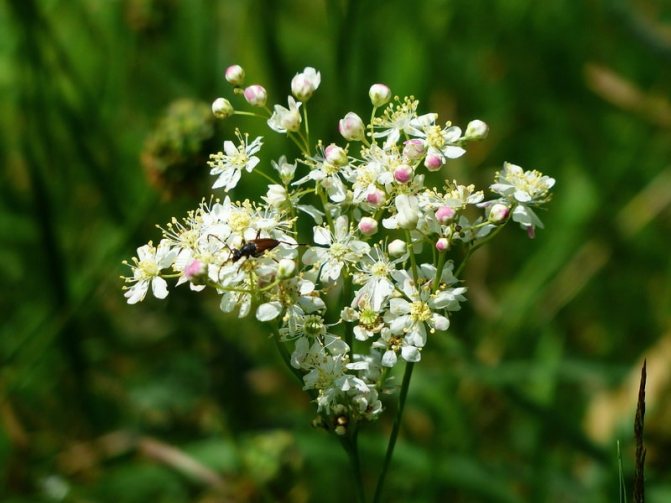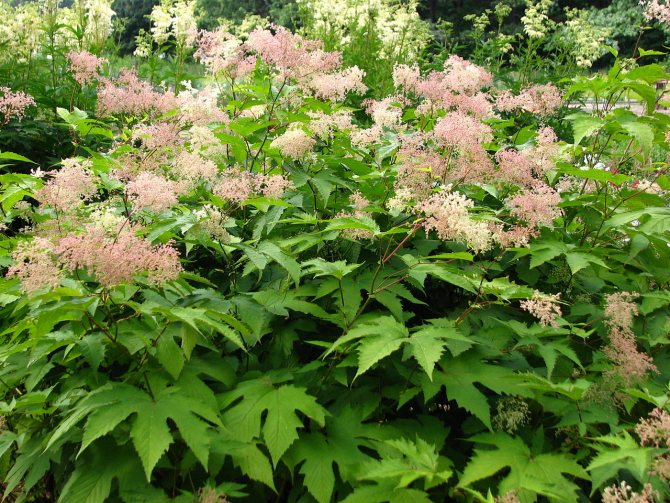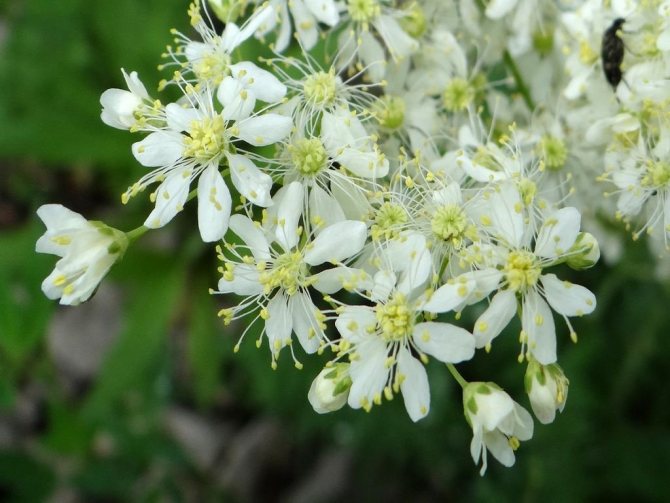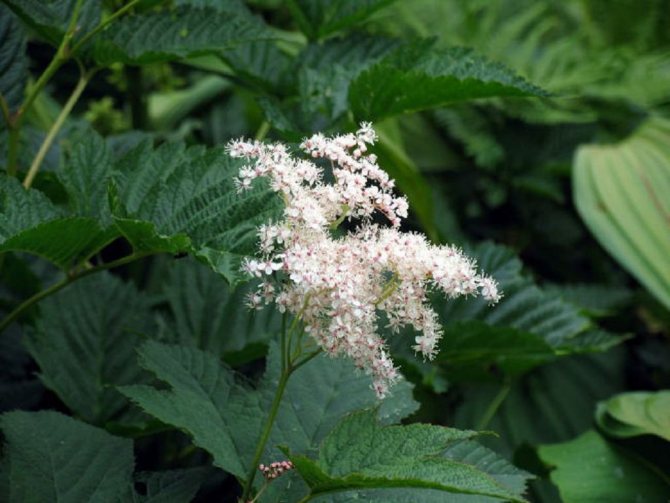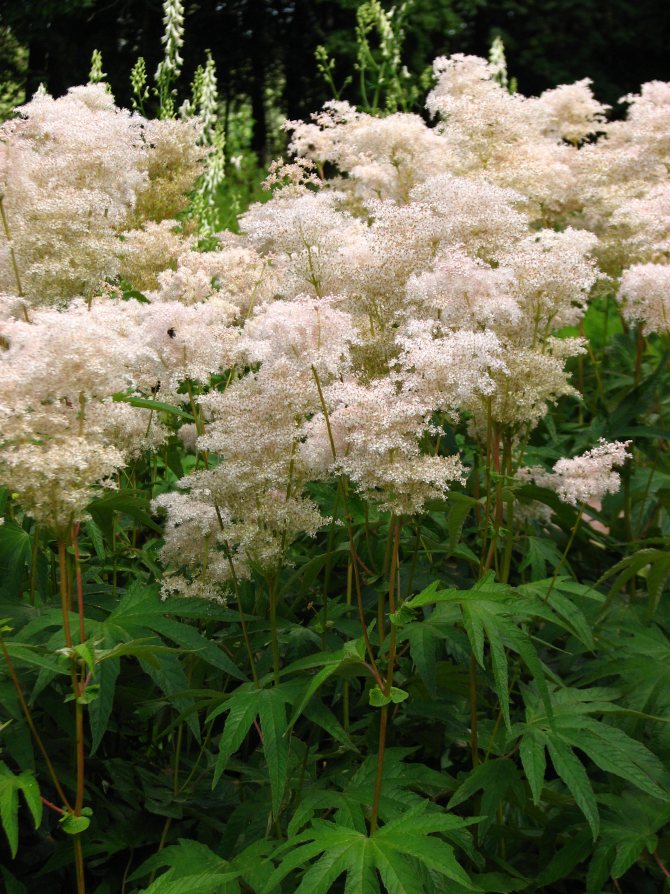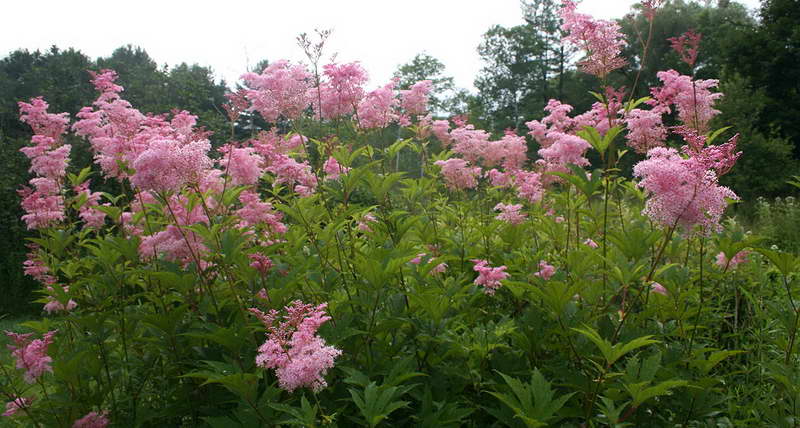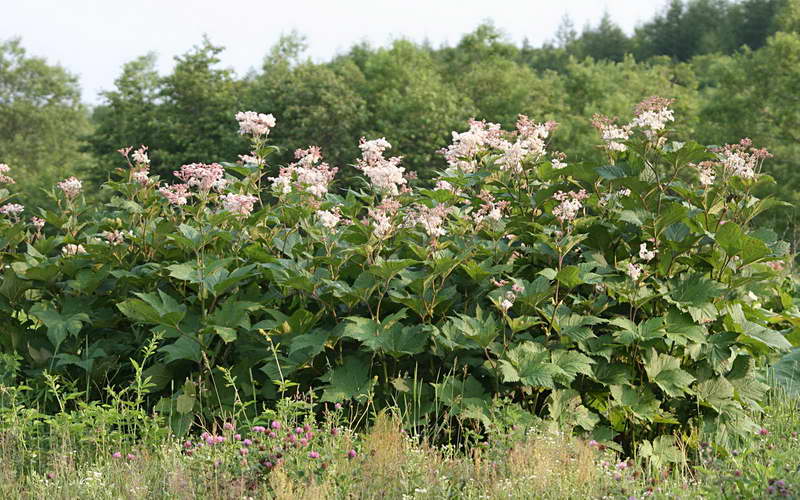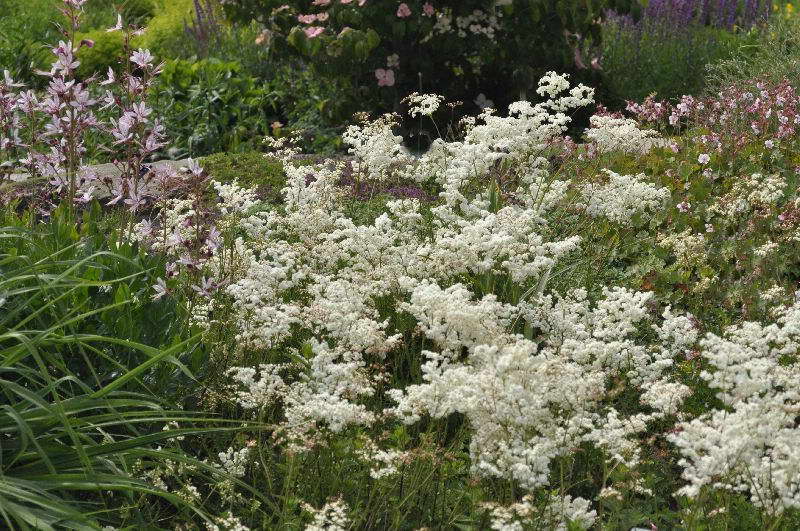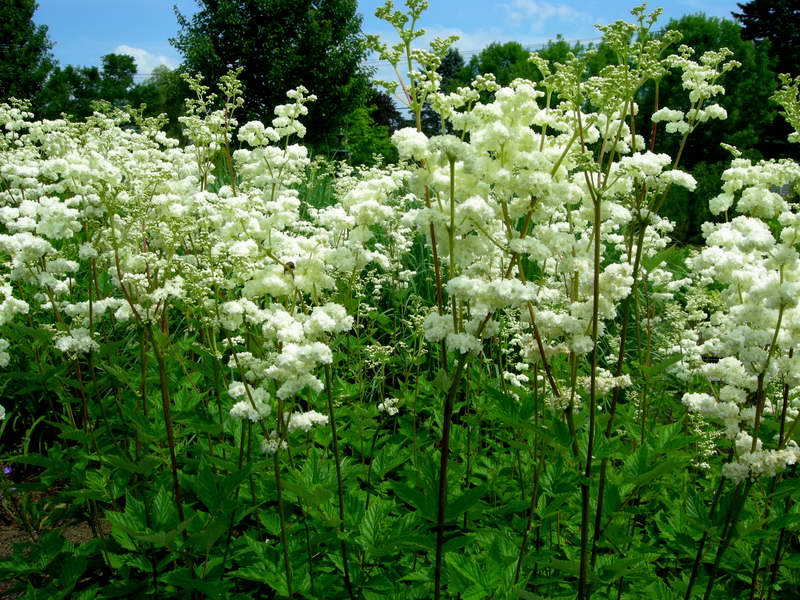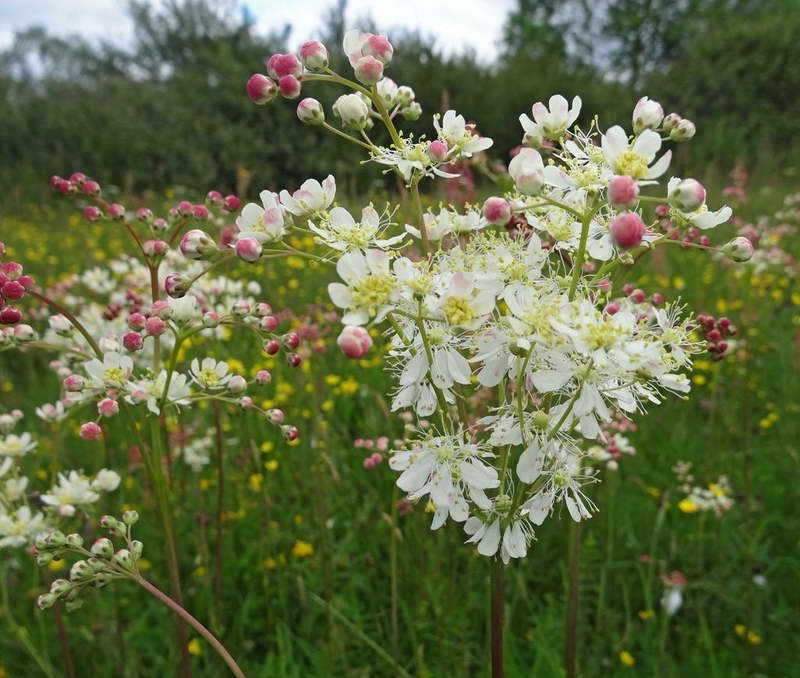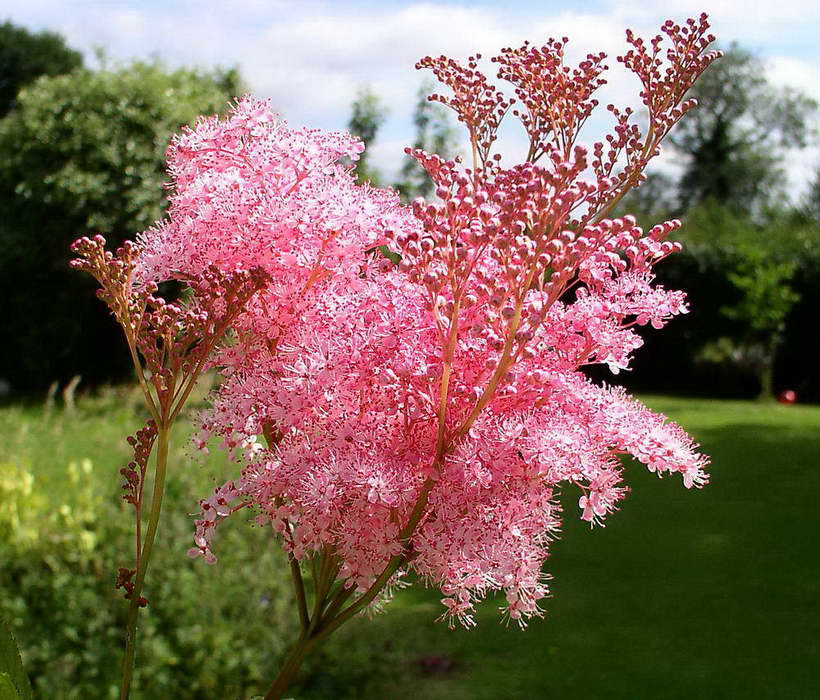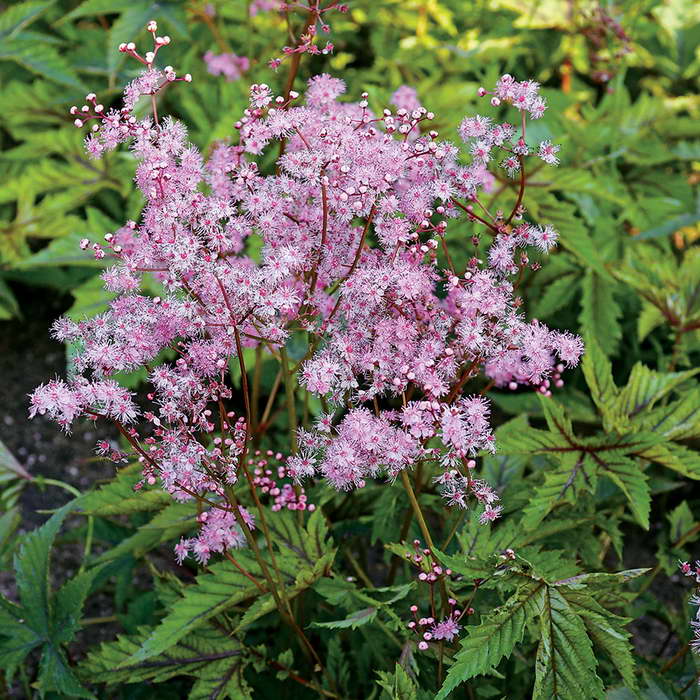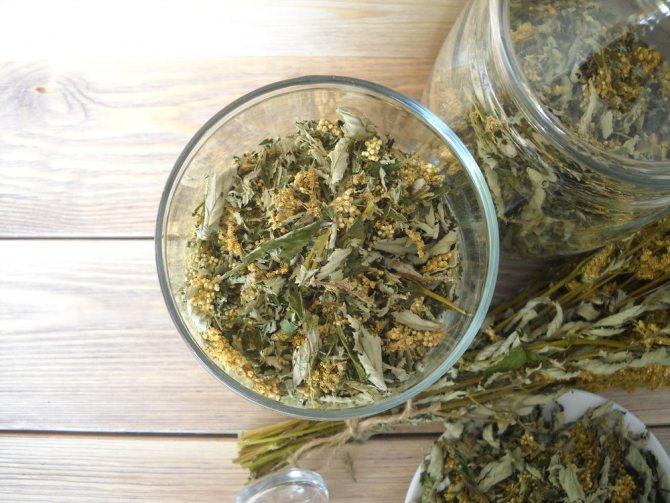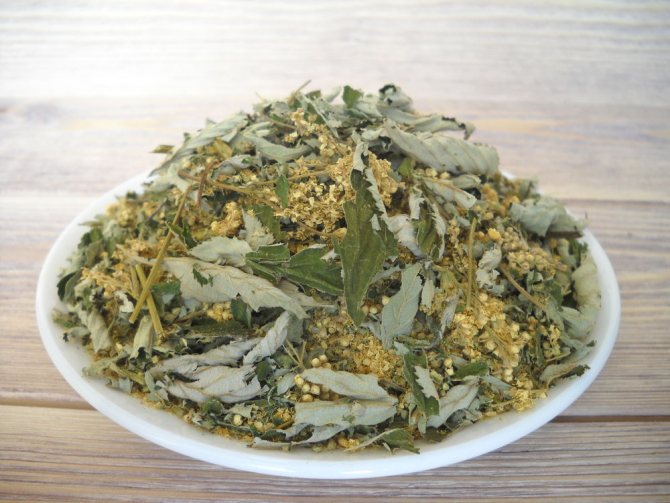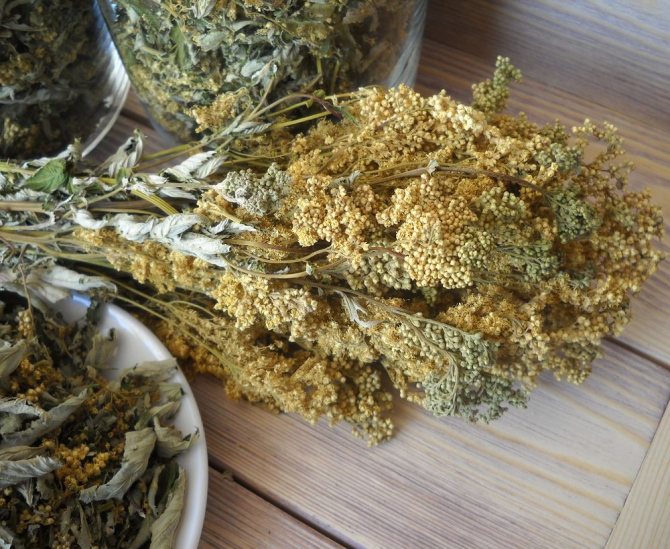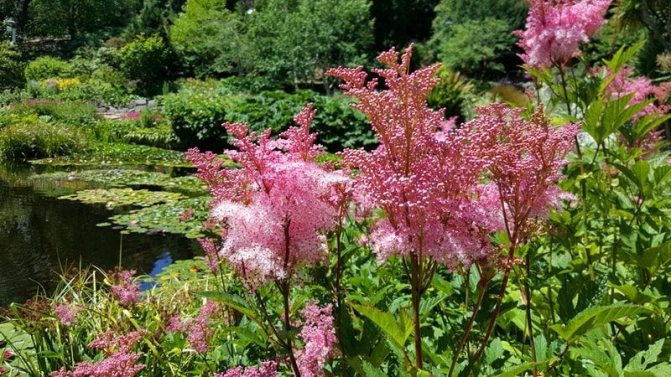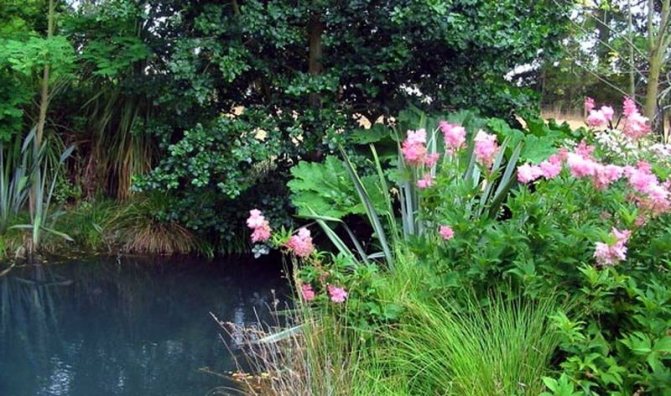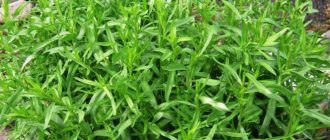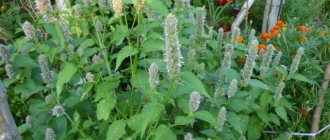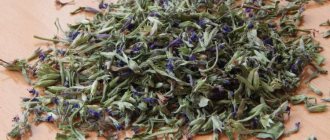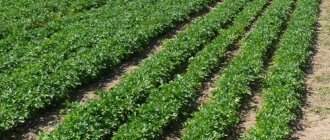If you have ever seen the meadowsweet, then you know why it was named the king of the meadows. This wild, ubiquitous plant dominates the meadows that are its home. Its modern common name can be associated not only with its habitat, but also with its use as a flavoring agent in honey and ale, as well as with the medicinal properties of meadowsweet. Photo of the plant.
Classification
Meadowsweet is a typical representative of the genus Meadowsweet, subfamily of rose hips, family Rosaceae. The name of the genus in Latin is Filipendula, which means "hanging threads", as its roots are suspended on thin threads.
The name of the species is visleaf, a derivative of the noun "elm".

The people also call it meadowsweet, lungwort, whitehead, honeydew.
Growing conditions
Next, we will consider the features of growing a meadowsweet - planting and care in the open field, a photo of flower beds with meadowsweet.
Location
For meadowsweet, moist areas are quite suitable, but without stagnant water. If the groundwater comes close to the soil, it will be necessary to organize a high bed with good drainage.
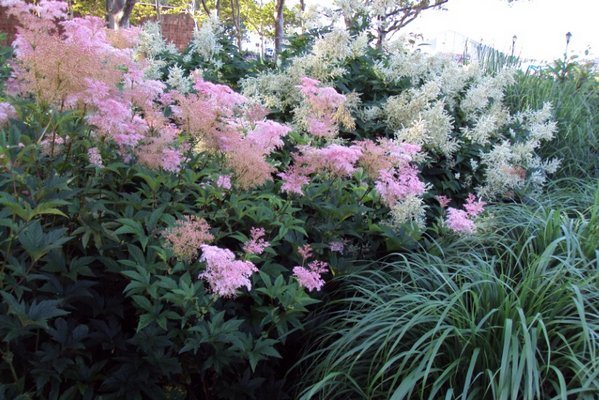

It can grow in shaded places, but does not tolerate the complete absence of the sun. Therefore, it is better to choose areas that are well lit by the sun or with light partial shade from neighboring plants.
Soil requirements
Tavolga does not set any special requirements for the soil. But it is better to grow it on neutral, fertile land. For acidic soils, add lime or ash to make them neutral. Before planting, it will be useful to add humus or compost.
Add sand to heavy soils - meadowsweet requires good drainage. Mix them in about a 1: 1 ratio.
Description of the species
The meadowsweet is a perennial up to 2 m tall. You can recognize it by the ribbed erect stem, the next pinnately large (up to 30 cm) leaves. The top of the leaf is dark green, and the bottom is white-felt. The leaf is ovate-lanceolate, with a sharp jagged edge, stipule and a shortened petiole.
It differs from its counterparts in feathery leaves, where small leaves are located between large corrugated sheets.
The fruit is a twisted spiral seed with sickle-shaped nuts.
Small meadowsweet flower (up to 8 mm in diameter), consists of five white or cream-colored petals. Numerous flowers are collected in the apical inflorescences of the paniculate-corymbose type.
It differs from the six-petal meadowsweet not only in the number of petals: on the roots it has thickenings in the shape of a ball, therefore the six-petal is also called earthen nuts. The root of the five-leaved meadowsweet is powerful, thick, creeping; in the elm-leaved species, it is without thickenings.
The meadowsweet loves flooded meadows, waterlogged river banks and swamps of various types with fertile land. There is a lot of grass in the alder thickets. In the floodplain of a forest stream, it can form a hard-to-pass carpet. Healing raw materials are collected in the central zone of the Russian Federation, in the Far East, in Altai, and the Urals.


Loves places with high humidity, swampy and damp meadows, forests.
Reproduction
Quite often, people plant a meadowsweet using seeds.The growth of the planting material is hampered by the waterproofness of the shell and the deep physiological dormancy of the seeds. The state of dormancy can sometimes drag on so much that some of them will begin to germinate only the next year after natural stratification.


Reproduction of Labaznik
Milk thistle herb: description, properties and uses
To get seedlings at home, you will need to use one of the traditional techniques:
- stratify the seed at low temperatures in the refrigerator or just under a layer of snow;
- to carry out treatment with growth regulators and a solution of micronutrient fertilizers;
- carry out scarification by soaking the planting material in water for 5-8 days (you can alternate the process of soaking with drying).
Important! Meadowsweet seeds are photosensitive. That is why it is not recommended to cover them abundantly with soil. The optimum temperature for growing is considered to be between 17 ° C and 25 ° C, which is combined with natural light.
If the seeds do not germinate, the seller is not always to blame. As a rule, planting material, in spite of the place of collection and ecological conditions of cultivation, can have different germination and germination friendliness. Seeds that have been harvested from dry habitats have the greatest chance of sprouting. The germination rate is maintained for 6 years.
When the following conditions are met, seed propagation of meadowsweet will be very effective:
- The moisture content of the soil must be high.
- Before sowing, seeds must be treated with growth stimulants, which affect the level of germination.
- The first months after emergence, they should be shaded. In nature, the grass gets used to the lack of sunlight in the first year of growth. It is very important to adhere to the natural growth conditions of the plant.
Note! The growth of the meadowsweet is slow. The rosette begins to form only 24 months after germination. The grass will delight with flowering for 9 years after planting (at home) and for 5 years (in natural conditions).
Experts consider it advisable to use a vegetative reproduction method, which can be carried out using special formations:
- root tuber (in the common meadowsweet);
- root suckers in the elm-leaved type of culture.
Whitehead composition
The herb is rich in essential oils, gaulterin, spirein, vanilla, glycosides, terpein, wax, tanning compounds, vitamins, fats. Flowers are valued for their essential oils, spirein glycoside. Gaulturin was found in the roots.
Herbalists prescribe herb as an astringent if the rhythm of bowel movements is disturbed. It also has diaphoretic, choleretic capabilities, as well as diuretic properties; strengthens the immune system, has sedative and anesthetic effects.
It is used for colds as an antiseptic, anti-inflammatory, immunostimulating, bactericidal agent.
Meadowsweet in landscape design
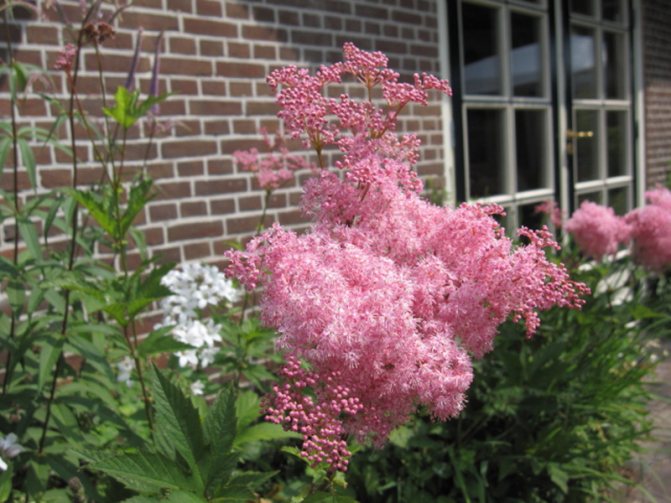

Tavolga on a personal plot
Meadowsweet or meadowsweet is used in solo and group plantings.
Airy inflorescences of unobtrusive shades can "dilute" an overly bright flower bed. Can be placed in the center of a flower garden, surrounded by low-growing flowers. Group landing in the background gives the impression of a white or pinkish haze.
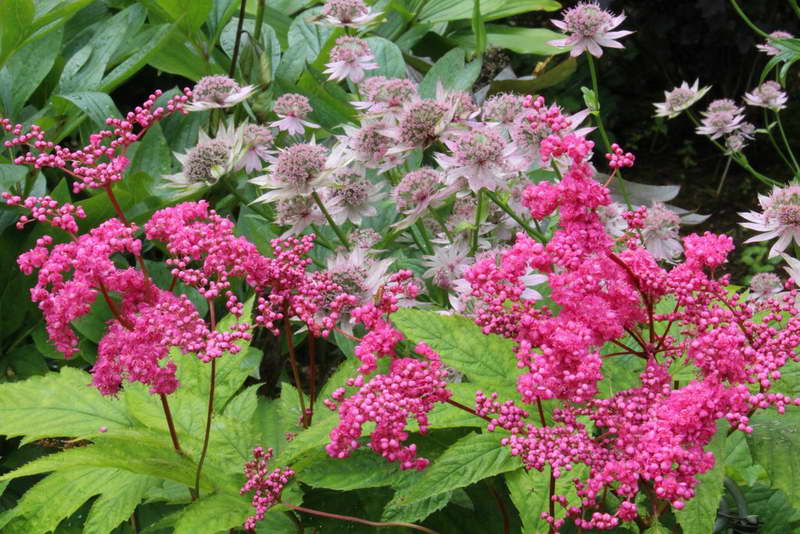

Tavolga and astrantia on a flowerbed photo
Tall varieties are used to create a hedge, zoning a site (you can separate a sandbox, a gazebo). Low-growing ones are good in border plantings, for framing flower beds.
Combine different varieties of meadowsweet. Plant in mixborders.
Plant around the perimeter of a fence or at home, arrange a garden path - touching inflorescences look elegant and solemn.
Suitable partners: ferns, lilies, astilba, irises, Caucasian scabiosa, carnations, peonies, spotted loosestrife. You can create a scenic fence in a duet with hydrangea. It goes well with marigolds, various host varieties.
Due to the moisture-loving meadowsweet, it is used to frame artificial ponds. A spectacle of incredible beauty: a weightless blooming cloud is reflected in the water surface.
> Beliefs
Our ancestors believed that the plant is able to protect against evil spirits and the evil eye of people. For this, pieces of the stem or rhizomes were placed under the pillow.
Pharmacological features
The most valuable from a medicinal point of view is the meadowsweet plant. Traditional medicine uses meadowsweet flowers to treat a wide range of diseases. Their medicinal properties and contraindications are due to their unique chemical composition:
- vitamin C - strengthens the immune system;
- wax - has antimicrobial and astringent effect;
- essential oils - useful for the digestive tract, cardiovascular and respiratory systems;
- starch - has enveloping properties that protect the mucous membrane from damage;
- fatty vegetable acids - take part in the creation and restoration of cell tissue;
- glycosides - provide sedative, antibacterial and laxative effects;
- phenolcarboxylic acids - naturally cleanse the body, prevent cell aging;
- flavonoids - relieve puffiness, spasms, allergy symptoms;
- salicylic acid - relieves inflammation;
- phenolic compounds - normalize the work of the biliary tract and the genitourinary system;
- tannins - control the viscosity of the blood.
Appearance and composition
Whitehead looks like a tall plant with a strong stem and powerful root system. It blooms in early summer, and its small flowers are collected in large cups. Meadowsweet can be white and pink. The plant prefers to choose open spaces, does not like "extremes" in summer: drought and heavy rains.
It is often specially planted in gardens for subsequent collection, since meadowsweet excellently repels insects.
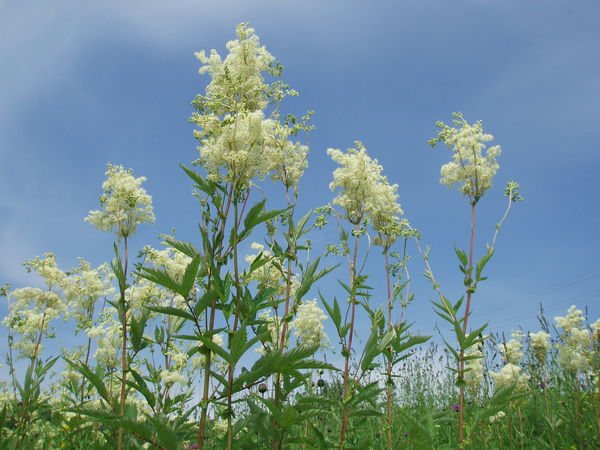

Whitehead blooms in early summer
The flowers of the plant have a subtle honey flavor, which is why they are used in the Scandinavian countries as a natural flavoring agent for beer and wine. Whitehead tea perfectly tones the body, and its tincture is used as a base for compresses. The flowers and leaves of the plant include ascorbic and salicylic acids and tannins.
Meadowsweet in folk medicine
Phytotherapists and healers make medicines from all parts of the medicinal plant.
Flower tea is used as a diuretic for nephritis, gout, rheumatism, renal failure, pain in the gastrointestinal tract, heart, arterial hypertension, hernia, leukemia. It is also effective as a hemostatic.
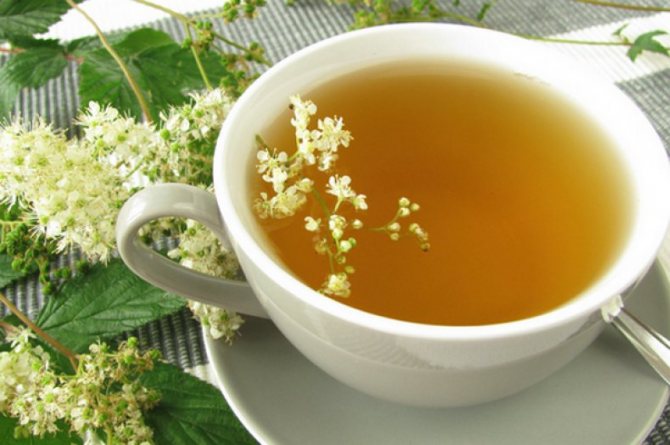

Powder from dried flowers is used to eliminate diaper rash on the skin of infants. It also has repellent properties: if you moisturize the skin with fresh plant sap, it can repel insects.
A decoction of lungwort treats diseases of the respiratory system, treats wounds with suppuration, is used for irrigation in gynecology, and enemas are given for diarrhea. Compresses can also be applied in case of skin damage.
A decoction of the root is effective in diabetes (including gestational), diseases of the joints and thyroid gland, and oncological problems. Traditionally, in Slavic cuisine, grass and flowers were added to first courses, drinks and desserts.


A little about the beneficial properties of meadowsweet
In folk medicine and cooking, all parts of the plant are used, the use of meadowsweet is very wide, its useful properties can be enumerated endlessly! The dried flowers are used to brew tea, which has a pleasant honey aroma.By the way, the smell of meadowsweet scares off flies and mosquitoes, but bees really like it. All types of plants are excellent melliferous plants, but in some people, meadowsweet pollen can cause allergies.
We have already mentioned that meadowsweet is a plant-indicator of groundwater, even our ancestors determined from it a place where you can dig a well. In ancient times, meadowsweet was considered a plant-amulet; pieces of root or stem were carried with them to protect against any evil.
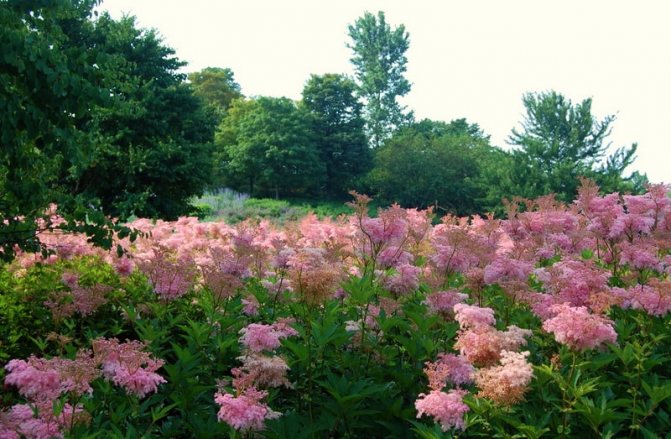

Perhaps for some gardeners, the meadowsweet seems too simple, unattractive plant. But just take a closer look, is that so? Its delicate, airy, fluffy buds and alluring aroma are truly worthy of respect. And, as you have seen, planting and caring for a meadowsweet is not at all burdensome, so feel free to plant this unpretentious perennial in your area, and soon it will become one of your favorites!
Well, we will return to the topic of breeding a little later, so stay with us and you will learn a lot more useful things about unpretentious garden plants. And in order not to miss publications, subscribe to the newsletter of announcements of our site:
Use of lungwort in everyday life
Gardeners willingly cultivate the plant in landscape design. In addition to the decorative function, the plant fills the site with a pleasant aroma for the whole summer. They use a kind of sachet for aromatizing rooms, linen, desserts.
Rhizomes in the southern regions of the country are popular as a spice. Sour-tasting leaves are used in salads and first courses. The aromatic herb is added to homemade wine and even to tobacco (snuff).
There are many useful substances in the whitehead, therefore meadowsweet serves as a good vitamin supplement to the diet.
A couple of branches of meadowsweet are added to a broom for a bath made of oak or birch. The advice is especially relevant for abrasions, wounds and inflammations.
Cosmetologists use meadowsweet decoction to restore oily problem skin prone to acne formation. If inflammation spreads to the scalp, rub the infusion into the scalp.


Powder from dried meadowsweet flowers is always in the herbalist's first-aid kit: they are sprinkled with acne, boils and other skin lesions, including purulent ones.
Diseases and pests
Tavolga is a medicinal herb that is naturally endowed with strong immunity. Taking care of the plant, you can protect it from the appearance of various ailments. Only:
- Powdery mildew. Most often, the Kamchatka species of meadowsweet suffers from this fungal disease. When affected, young shoots of meadowsweet are covered with a whitish-gray loose bloom. A month later, the sporulation of the fungus captures the foliage, flowers and the bracts. For the treatment of powdery mildew, experts recommend treating the herbaceous culture with a solution of colloidal sulfur. You can also use soda ash. The affected parts of the grass must be urgently cut and burned.
- Rust, most often affecting the meadowsweet. A sign of damage will be the appearance of red-brown pads of a fungal nature on the foliage of the plant. In an adult grass, massive damage to the leaves of root rosettes is most often observed. Experts advise treating the infected bush as soon as possible with a fungicidal preparation, for example, topaz, chorus and cuproxate. Processing is carried out at a mandatory interval, which should last 8-10 days. Spraying the bushes should be carried out until the unpleasant symptoms are completely eliminated.
Pests such as:
- Aphids are small parasites that feed on plant cell sap. As a result of their "labor", the foliage of the grass curls and dries up. Affected clusters become dense, small buds dry out almost immediately after blooming. Aphids can affect any species of meadowsweet, except for the common one.
- Wireworm is a click beetle larva that damages the root system of a crop. You can get rid of the wireworm by treating it with strong soap solutions or insecticidal preparations such as actellik, karbofos and biotlin. You can harm harmful larvae by liming the soil on the site.
Meadowsweet grass: medicinal properties, indications and contraindications
A universal drug is effective in treating a wide variety of ailments:
- headache;
- rheumatism, gout and arthralgia;
- diabetes mellitus (including in pregnant women);
- epilepsy and smooth muscle spasms;
- dysentery and diarrhea;
- hemorrhoids and worms;
- inflammation of the urinary tract,
- hypertension;
- inflammatory processes in the sciatic and trigeminal nerves, insomnia, neuritis of the facial nerve;
- diseases of the respiratory system (tonsillitis, pneumonia, asthma);
- respiratory infections,
- bedsores, purulent wounds;
- psoriasis, ulcers, shingles;
- malignant tumors (in some cases);
- polyps of the gastrointestinal tract;
- cardiovascular failure (shortness of breath, edema, thrombophlebitis, anemia);
- gynecological pathologies, incl. infertility;
- intestinal atony and hepatitis.


A decoction of meadowsweet also helps with snake bites.
Despite the low toxicity class, meadowsweet is not prescribed for pregnant women, lactating mothers and children under 12 years of age.
It is also contraindicated in the following conditions:
- chronic constipation;
- arterial hypotension;
- poor blood clotting;
- thrombocytopathy;
- hypersensitivity to the components of the product.
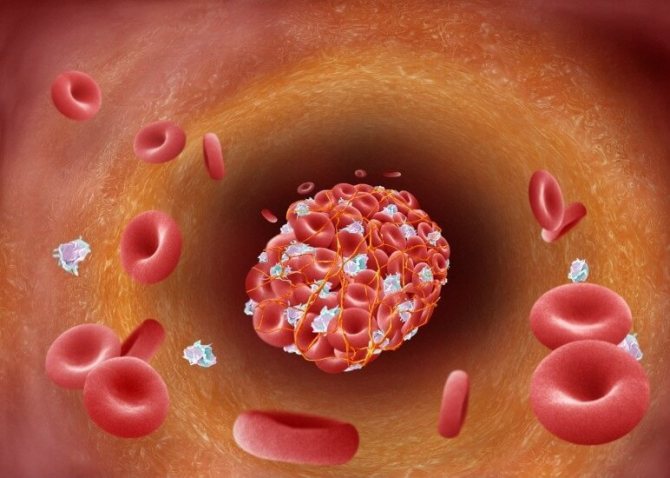

Poor blood clotting
When deciding on the treatment with lungwort, coordinate your intentions with a specialist. The doses and frequency of administration indicated in the recipes are approximate, presented for general information.
Features of each part of the whitehead
All parts have healing powers: stem, flowers, roots. The root is suitable for eliminating the symptoms of hypertension, nervous disorders, and diseases of the respiratory system.
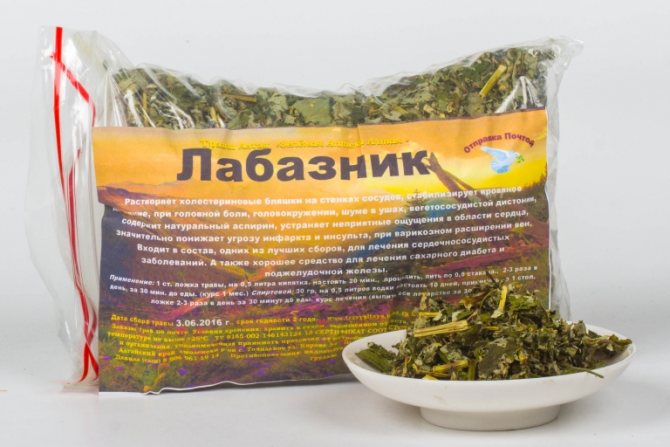

Tincture of the root removes worms. In complex collections, the rhizome is used as a sedative, antispasmodic, analgesic. They also help with bleeding. Pharmacists based on the root make herbal medicines (extract, extract).
Herbal tea will relieve fatigue, normalize sleep. It is also shown with rhinitis. Powder is useful for treating burns and wounds.
Flower teas are used as a diuretic, astringent, diaphoretic, anthelmintic agent. The drink relieves pain in the gastrointestinal tract, is effective in heart failure, relieves nervous spasms and migraines.
Care
Meadowsweet is considered a fairly unpretentious plant, responds well to mineral fertilizers, loves timely watering, but it can exist for some time without it. Does not tolerate acidic soils.
To feed the meadowsweet, it is better to use complex mineral fertilizers. Potash fertilizers will have a beneficial effect on the overall resistance of the plant and increase the decorative qualities.
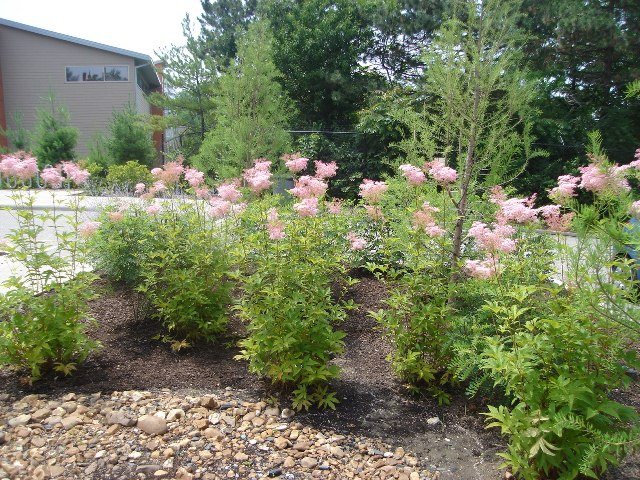

Filipendula rubra, cultivar Queen of the Prairie
Dosage forms and doses
Various types of medicines are prepared from meadowsweet: tinctures, decoctions, powders, teas, creams, ointments.
Alcohol tincture
Infusion treats non-healing purulent wounds, boils, trophic ulcers. The drug has a bactericidal effect, promotes the speedy regeneration of damaged skin.
The sedative and antispasmodic effect allows the use of the infusion for disorders of the central nervous system, gastrointestinal ulcers. Tincture treats hormonal disorders, goiter, gynecology.
To prepare a tincture for external use, vodka must be added to dry grass (for 1 hour of raw materials - 5 hours of vodka) and kept in a dark place for at least 5 days. If the medicine was purchased from a pharmacy, take 25 drops dissolved in 50 ml of water. Frequency rate of admission - 3 rubles / day, before meals.
Decoction
The remedy treats some types of oncology, hypertension, nervous disorders, rheumatism, intestinal infections, dysentery, inflammation of the urinary organs, epileptic symptoms, gout.
Prescription for 1 tsp.a spoonful of chopped dried raw materials should be taken 0.5 liters of water. Soak the broth for half an hour for a couple, filter and dilute with boiled water. Drink on the table. l. 3 rubles / day after meal.
Recipes for using meadowsweet
To use meadowsweet for medicinal purposes, decoctions, infusions, ointments, and tea are made.
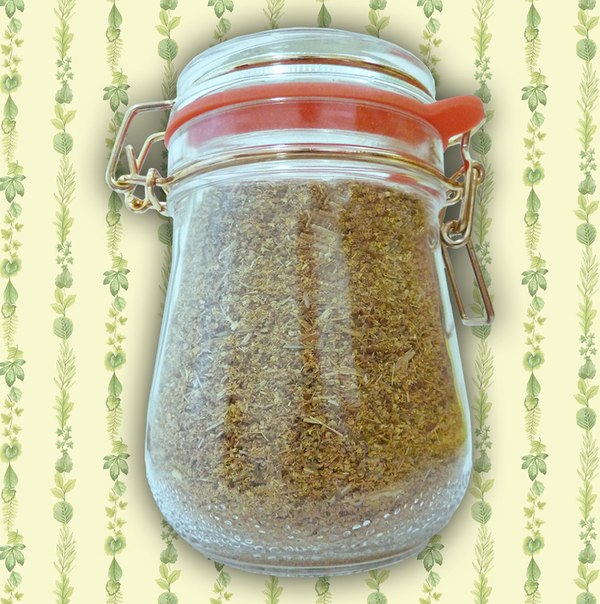

Infusions
The meadowsweet infusion is very useful for patients with diabetes. It lowers blood sugar levels.
Infusions are used in the treatment of rheumatism, hemorrhoids, suffocation, insomnia, hernia, thrush, infertility, bleeding, psoriasis, anemia, diarrhea, mastopathy, gastrointestinal diseases, etc.
- You can prepare an infusion from the rhizomes of meadowsweet. For this, 1 tsp. rhizomes need to be filled with 250 ml. boiled water, while it should be cold. He must insist for eight hours. Consume in small sips throughout the day.
- To prepare an infusion of meadowsweet, you need 1 tbsp. pour herbs with sprouts with 1.5 liters of boiling water and leave to infuse overnight. This infusion is used 4 times a day, 50-60 ml. before meals.
- Infusion of Kamchatka meadowsweet 1 tbsp dry chopped herbs must be poured with one glass of boiled water and left to infuse for 2 hours. Consume 4 times a day, 50 ml.
Decoctions
- A decoction from the roots of meadowsweet is used for malignant tumors, nervous diseases, epilepsy, hypertension. Decoctions of meadowsweet herb are also good for shampooing, it accelerates hair growth. It is also used in the form of douching. For this 25g. meadowsweet is poured with 1 liter of water.
- To prepare the broth, it is necessary to pour 5 g of six-petalled meadowsweet rhizomes with a glass of boiled water and cook for another 15 minutes. Then you need to cool and strain. With this broth, you can wash purulent wounds, snake bites, and douche.
- A decoction of meadowsweet can be prepared as follows: 1 tbsp. dry leaves in a crushed form, pour one glass of water and boil for another four minutes. Leave for 2 hours and drain. Use a warm broth for half a glass three times a day.
- For toothaches, boiled meadowsweet leaves can be applied to the tooth, as they have anesthetic properties.
Tincture
The tincture is used to treat wounds, ulcers, skin diseases. It is also used for hormonal imbalance, goiter, and other female diseases.
- Tincture for compresses: the dried herb must be poured with vodka (1: 5, respectively). Insist 5 days.
- Mix 50 g of meadowsweet flowers, 1 l. vodka, 20 g of sugar. Insist 12 days. Drink the tincture three times a day, 30 drops. It is useful for stomach ailments.
Tea
- Tea is brewed from meadowsweet flowers: 1 tsp for 1 glass of boiled water. Insist 5 minutes. This tea strengthens the immune system and is also used as a diuretic.
Ointment
It is used for rheumatism, various skin diseases. Meadowsweet ointment can be prepared from grass, as well as from the rhizomes of the plant.
- To prepare the ointment, you need to grind 20 g of rhizomes until you get a powder. Then mix the powder with 90 g of butter (either petroleum jelly or lanolin). Apply the ointment 3-4 times a day.
Harvesting meadowsweet
Whitehead flowers are usually harvested as medicinal raw materials. The best time to harvest is July-August, the period of mass flowering. The panicles are cut to the first leaf and dried in the shade in a draft at a moderate temperature.
Store raw materials in a tightly closed box. Competently prepared raw materials will be brown in color, with a characteristic odor and a bitter-tart taste.
If you need to prepare the roots of meadowsweet, then it is better to dig them up in the off-season. Freeing the rhizomes from the ground and stems, they are washed in cool water, cut into pieces of 10-15 cm and dried under the same conditions, spreading them in a layer up to 1 cm on cloth or paper.
It can be stored in bags or containers made of wood or glass. The shelf life of such a blank is 3 years if stored in a cool dry place.
When to collect and how to dry (preparation for the winter)
To preserve the medicinal properties, the raw materials must be properly collected and dried. Young leaves and shoots are harvested a few days before flowering, that is, in early to mid-June. The inflorescences are plucked directly during their flowering.
Shoots are collected in bunches and dried outside in the shade. Damaged and rotten parts are removed before drying. After complete drying, they are folded into linen bags or glass jars.
The meadowsweet roots are harvested in late autumn, cleaned from the ground, dried and only then crushed.
Raw materials can be stored for 2 years, but they will bring the greatest benefit during the first year.

